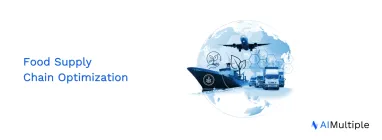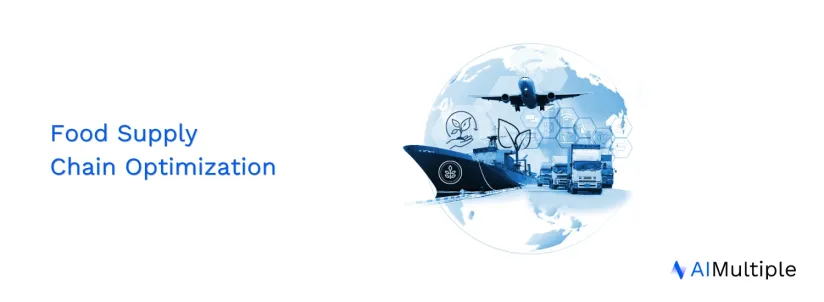Top 4 Ways to Improve Your Food Supply Chain in 2024


It has been nearly 2 years now since the global pandemic changed life as we knew it. Some businesses have started to recover from the damage caused to their supply chains, while others are still trying to find their way out of the rough waters. In food supply chains, the main areas which got impacted were:
- farming
- logistics
- food processing plants
- food retailers and grocers
Supply chain managers in the food sector are trying to overcome these challenges with digital solutions and strategic thinking to optimize supply chain and logistics operations.
This article explores 4 ways supply chain managers in the food sector can optimize operations to overcome current and future challenges.
Automating demand planning
One of the main problems during the pandemic was a lack of planning for the demand surge. When people started panic-buying food, the suppliers did not have enough stock to replenish in time, which resulted in empty shelves at the retailers’ end. More resilient and accurate demand planning can help supply chain managers prepare for future uncertainties.
Supply chain managers can leverage demand sensing technology to improve their predictive capabilities. Demand sensing uses innovative methods such as AI, ML, and data (historical and real-time) capturing and processing to accurately forecast demand.
Walmart has created a weekly demand sensing system to improve its demand forecasting accuracy for all of its stores in the US, Canada, and Mexico to improve predictability and reduce uncertainty across the supply chain.
To learn more about AI-enabled demand forecasting, check out this comprehensive article.
If you wish to find the digital solution that best suits your supply chain planning needs and goals, check out our data-driven list of supply chain planning software.
You can also check our data-driven list of the top no-code supply chain software to find the best option that suits your business.
Improve supplier network and relationships
The pandemic has identified the importance of strong supplier relationship management in all sectors.
Strengthen relationships
Businesses are moving from transactional relationships to partnerships with suppliers with mutual understanding, benefits, and growth. Supply chain managers can follow the following steps to improve their supplier relationships management operations:
- Establish a mutual understanding to understand your suppliers, their goals, missions, and vision and ensure they understand yours. This will enable strategic alignment with suppliers which is integral to fulfilling customer demand.
- Analyze and assess the complete supplier network to track performance and support the ones who need to improve their services to your business.
- Pay vendors on time, provide them with accurate client reports and remove mistakes from your back-office processes, such as invoice creation.
- Encourage collaboration with suppliers through digital solutions. Facilitate two-way data sharing to improve visibility across the vertical supply chain.
Tesco is also switching from a transactional relationship with its food suppliers to a partnership.
To learn more about improving supplier relationship management, check out this quick read.
Diversify the network
Dependency on a limited number of suppliers is also one of the key reasons for the collapse of the food supply chain during the pandemic. If those suppliers fail to deliver, the whole supply chain gets impacted. Therefore, having backup suppliers or a diverse network of suppliers can help make the food supply chain more resilient.
For example, retailers such as Carrefour (a French multinational retail corporation) contacted suppliers from Pakistan to fulfill the demand surge during the pandemic.
Optimize inventory and logistics operations
Digital solutions are helping optimize inventory management to reduce waste in food supply chains and bring inventory faster to store shelves.
AI-enabled inventory management software can analyze historical and real-time data to anticipate stock-outs and suggest optimal adjustments to demand and supply.
Since food is perishable, it can not be stored for a long period. Therefore, AI can help reduce inventory levels and waste that is created during the storage of excess food produce.
At the logistics end, robotic automation can significantly improve food warehouse operations to overcome the shortage of workers in the food sector and help speed up operations in the agricultural sector which is the main source of food.
Watch how companies like Ocado are completely automating warehousing for the grocery and food sector.
Check out these quick reads to learn more about how automation and AI can help improve supply chain and logistics operations.
You can also check out the comprehensive article on how digital solutions are improving the agricultural sector.
Improve sustainability
The food industry accounts for 35% of the total global greenhouse gas emissions. Global food supply chain managers need to refocus on sustainability since it has benefits beyond the environmental area.
Improve supply chain traceability
The demand for fairtrade products continues to grow. Supply chain managers in the food sector must know how and from where the supply is procured. Whether it’s daily groceries for a supermarket or raw materials for a food processing plant, supply chain managers must ensure that the supply is ethically and sustainably produced and delivered.
This significantly improves the company’s reputation and makes the brand attractive to suppliers and other business partners to work with.
The use of blockchain technology can help improve supply chain traceability in the food sector. IBM food trust is a global blockchain network that allows businesses to achieve true supply chain transparency and traceability.
See how it works.
Carrefour is expanding the use of IBM’s blockchain network from its food products to its textile products
Save costs
One of the current challenges the food sector faces is the rising cost of producing food. As inflation hits many countries in the post-pandemic world, supply chain managers can implement sustainable practices to reduce energy consumption and the cost of producing food. This can ultimately help them manage production costs and product prices.
Check out these quick reads to learn more about supply chain sustainability and how technology can help.
Further reading
- 3 Ways To Optimize the Automotive Supply Chain
- Top 5 Ways To Improve Supply Chain Resilience
- Top 5 KPIs To Measure Supply Chain Performance
- 3 Ways To Optimize Your Supply Chain
- 5 Ways to Improve Supplier Relationship Management
If you have any questions, feel free to contact us:



Comments
Your email address will not be published. All fields are required.